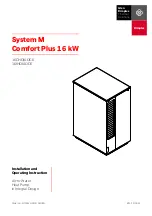
Teikoku USA | Chempump
Instruction Manual G-Series
18
3. Operation
3.1 Procedure Before Initial Start
Attention!
Before starting the pump for the first time, make sure suc-
tion and discharge piping are free of tools, nuts, bolts, or
other foreign matter. Save time and money by checking
before start-up.
Attention!
It is recommended to install a temporary cone-style strain-
er near the suction port to trap scale and other foreign
particles. Suction strainer to be sized and designed per
Teikoku recommendations. The screen can be installed for
24 hours of operation, but must be monitored closely so
the pump does not become starved for liquid because of a
clogged screen. Remove screen after 24 hours of running.
3.2 Preparation and Trial Operation
The following procedures are recommended for protection of
canned motor pumps in industrial services.
Teikoku USA recommends monitoring the differential pressure
and the power monitor for total protection of the pumps. Teikoku
recommends using both as differential pressure works best for
cavitation protection and the power monitor works best for no
flow, loss of flow and excessive flow. If only one method is going
to be applied then differential pressure would be the preferred
method.
The preferred method for differential pressure monitoring is to
install pressure transducers in the suction line between the pump
and the block valve and in the discharge line between the pump
and the first valve (either check or block). The signals from the
pressure transducers are then sent to the control system and the
pressure and time delay limits can be set within the control system
program. Calibration of the transducers should always be checked
as part of the installation process and startup of the system.
Recommended set points are:
• Differential Pressure (DP): 15 to 20 PSI below normal op-
erating differential pressure
• Time Delay (TD): 20 seconds or less
When using an automatic control system, the following param-
eters are recommended:
A. Single pump:
• 20 Second Delay: Low differential pressure trip
• 60 Second Delay: Pump Restart
Repeat above timing sequence for a maximum of 3 starts. If
low differential continues after 3 starts a manual reset of the
process controller is required.
B. Dual pumps:
• 20 Second Delay: “A” Pump low differential pressure trip
• 60 Second Delay: “B” Pump start
• 20 Second Delay: “B” Pump low differential pressure trip
• 60 Second Delay: “A” Pump start
Repeat above timing sequence for a maximum of 3 starts per
pump (6 starts combined total). If low differential continues
after 3 starts per pump (6 starts combined total) a manual
reset of the process controller is required.
Commercially available differential pressure switches are available
with little to no adjustment. These switches will work but with no
adjustment in the time frame or differential pressure set points
they typically will not meet Teikoku’s pressure and time delay rec-
ommendations.
The preferred method to monitor the input power to the pump
would be to use a power monitor like the Load Controls PMP-25.
The power monitor prevents failures due to loss of prime, no flow
and excessive flow. The performance curve of the pump is used
to set the low power and high power warnings and trip set point.
Actual operating data can be used to make the final adjustments
to the initial set points.
3.2.1 Setting of Thermal Overload Protective Device
Set the thermal overload protective device at the rated current
indicated on the nameplate. It is effective as a protecting device
for canned motors to set the thermal overload protective device
at as low current as possible. When operating current is far lower
than rated current, set the thermal overload protective device just
above the operating current not the rated current. Generally, it is
recommended to set the thermal overload protective device at the
following values:
• Variation of voltage and load is small: operating current
times 1.1
• Variation of voltage and load is big: operating current
times 1.25
Attention!
Do not set the thermal overload protective device at more
than the full load amps (FLA) listed on the name tag.
3.2.2 Priming and Venting
Complete priming should be carried out in the following order:
1. Open suction valve 100%
2. Open discharge valve 100%
3. If applicable: open reverse circulation line valve 100%
4. Open discharge pipe vent valve 100%
5. Open minimum flow valve (if required)
IMPORTANT!
NRTL certified per UL 778 & CAN/CSA
C22.2 No. 108-14 for operation between 25 HZ to
65 HZ with Pulse Width Modulated (PWM) Variable
Frequency Drive (VFD) power.
















































